How Bustle used data to excite clients and advertisers
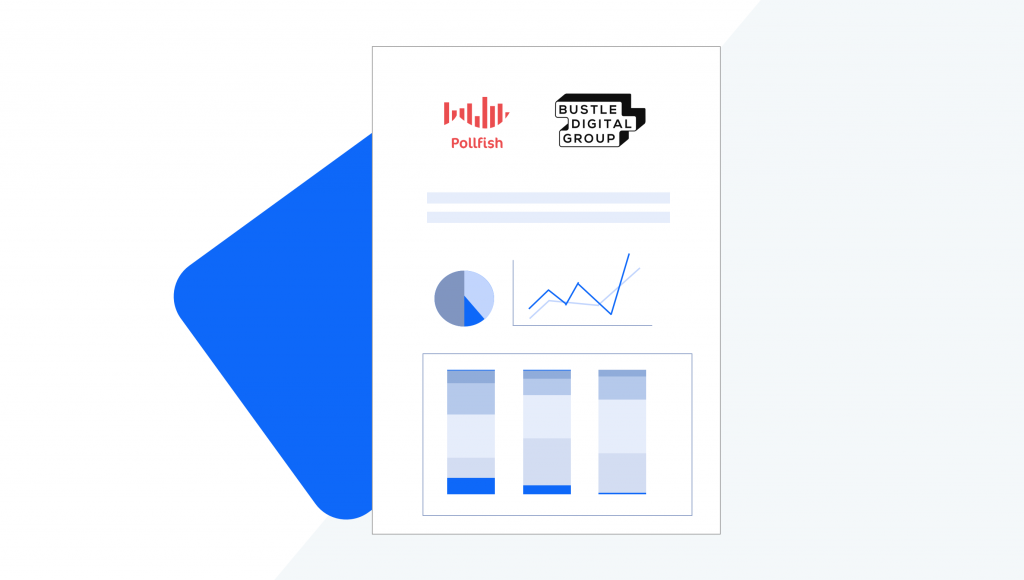
How Bustle used data to excite clients and advertisers
Major companies, like Bustle Digital Group, don’t rely on instincts to make the right decisions. Across departments, behind the scenes or in shareable reports, Bustle uses consumer data to keep leadership, external stakeholders, and team members informed about where their target audience’s behavior, wants, and needs.
This was particularly essential when the coronavirus pandemic hit, and many companies struggled to understand what it would mean for their business.
Consumer insights keep Bustle’s advertisers informed
Bustle Digital Group is a media company comprising 8 digital brands focused on Gen Z and Millennial audiences. The insights team is deeply attuned to the needs and wants of these audiences, understanding exactly what they most value, content types they like to consume, topics they care about and more. They also conduct consumer research on audience behaviors and attitudes to attract and retain advertising partners.
Although Gen Z is the demographic that spends the most time online and will soon account for 40% of all consumers, advertisers have found it difficult to connect with them. Digital natives are largely blind to advertising efforts and require much more personalized and creative messaging to get through than previous generations.
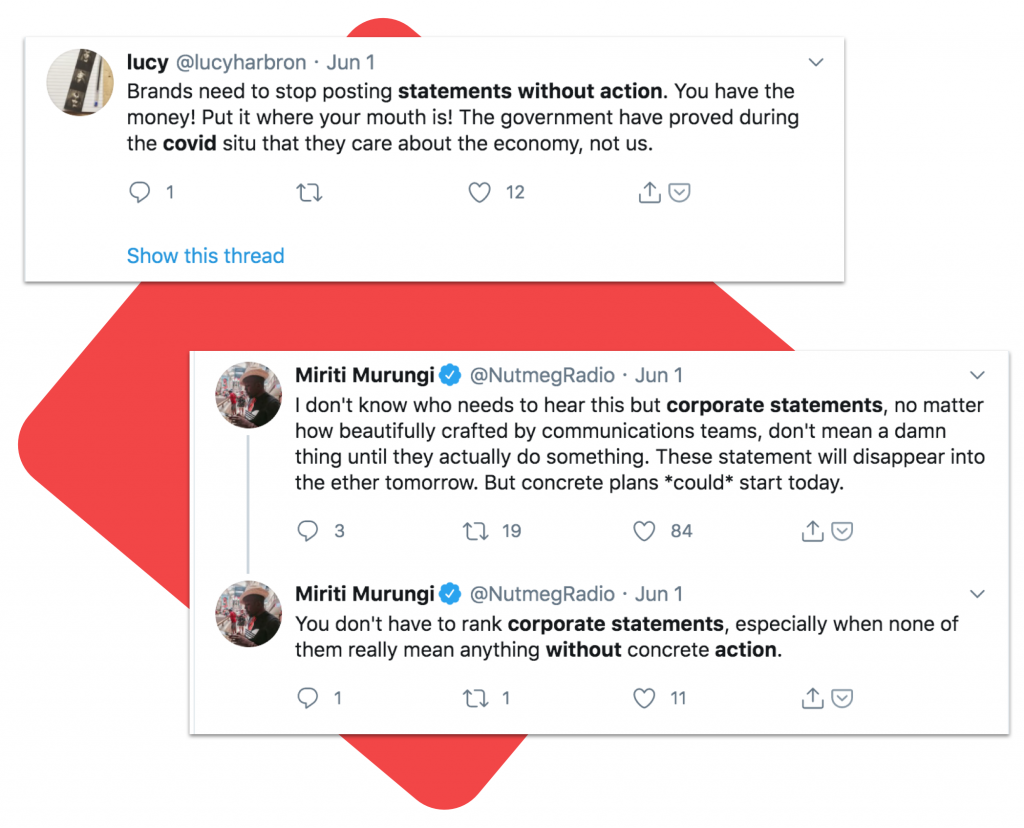
As a media company, BDG relies on revenue from their advertising partners—brands who hope to reach the same demographic makeup as their readers. BDG’s expertise and prominence in the Millennial and Gen Z landscape makes their publications attractive and powerful platforms for brands to reach their target audience while they read and engage with the content they came for.
Reassuring advertisers was critical during COVID-19
Understanding the target audience was especially critical during COVID-19. Not only for Bustle’s internal teams and editorial staff to ensure they were creating meaningful, supportive content, but also in terms of keeping their advertising partners informed.
Early on, the insights team at BDG asked consumers if they wanted brands to stop advertising, which kinds of messaging brands should be using in their advertising, and what brands can be doing to help the greater good.
They shared these insights with advertisers to let them know that running the same ads they would normally might be considered tone-deaf or insensitive, and potentially run the risk of alienating themselves from the target audience.
Bustle uses Pollfish to collect rapid consumer data
Bustle’s insights team used Pollfish to conduct consumer surveys to discover how Millennials and Gen Z were responding to the pandemic differently from other demographics, revealing data that advertisers were able to use to pivot their strategy for a more appropriate message during a difficult time.
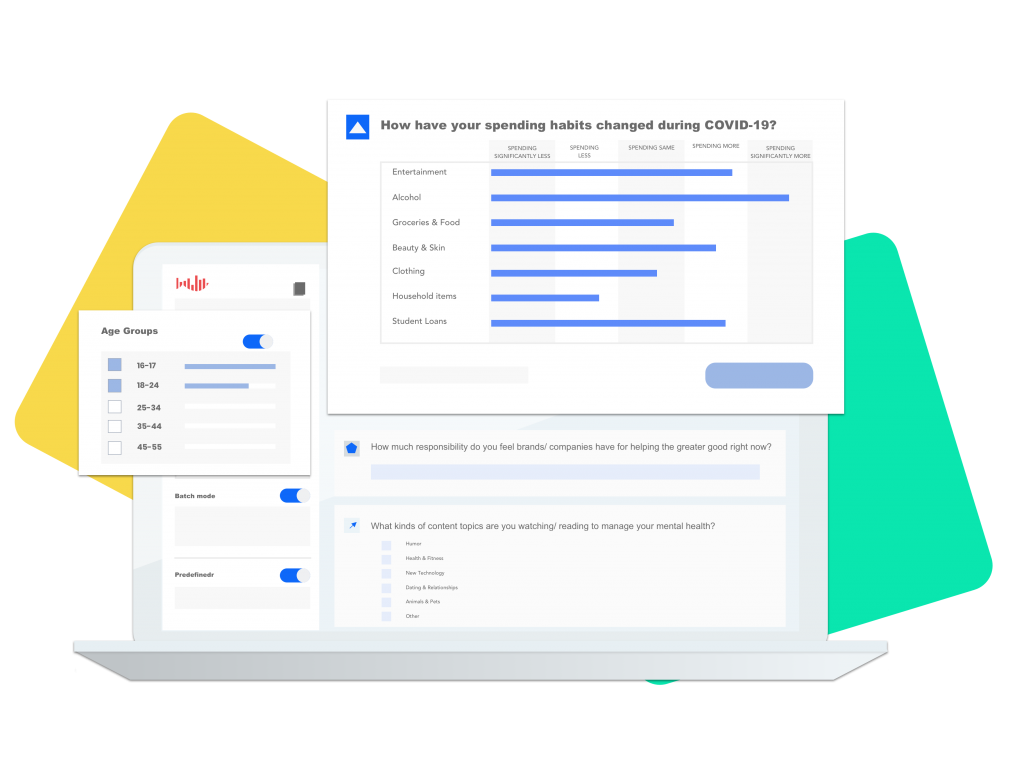
Target Audience Insights
They ran a survey in early March, near the beginning of the pandemic, using Pollfish’s targeting features to connect with their target audience demographic. The size and diversity of Pollfish’s audience is representative of the people that Bustle and their advertisers are trying to reach, giving them firsthand data directly from Gen Z and Millennial audiences.
Bustle Digital Group used Pollfish survey data to highlight key areas of opportunity among these core target audiences such as sustainability, mental health, and the importance of leaning into comfort to combat uncertainty during COVID-19.
Rapid reporting
Within 3 days, the insights team had data that they could quickly use to inform internal conversations, sellers, marketers, and advertisers.
Bustle compiled this data into reports for internal huddles and external distribution to help the entire business make rapid decisions that supported and served the target audience. The Bustle insights team assessed where their readership was, and what they cared about the most, as well as where the market was going.
Information has been used across departments, from editorial content development to the advertising sales team. Timely data releases highlighted in client meetings keep BDG top-of-mind and open the door to new conversations and opportunities for the business development team.
Pivoting strategy with data
They discovered that the “we are all in this together” messaging that was already gaining rapid popularity and inspiring memes, didn’t resonate with Gen Z audiences. Digital natives, it seems, are more skeptical of advertising, and want an action plan.
Brands that included in their messaging their next steps for donations, relief funds, or reallocating their resources and workforce to manufacture necessary supplies were much more well-received with the target audience.
Being able to quickly share these data-backed recommendations about their target audience and readership with advertisers such as Allbirds, Twitch, Publicis Group, and Volvo let Bustle reassure them that they were on the right track during COVID-19 and built confidence in their advertising plans going forward.
How Bustle is using Pollfish for Content Creation
How Bustle is using Pollfish for Content Creation
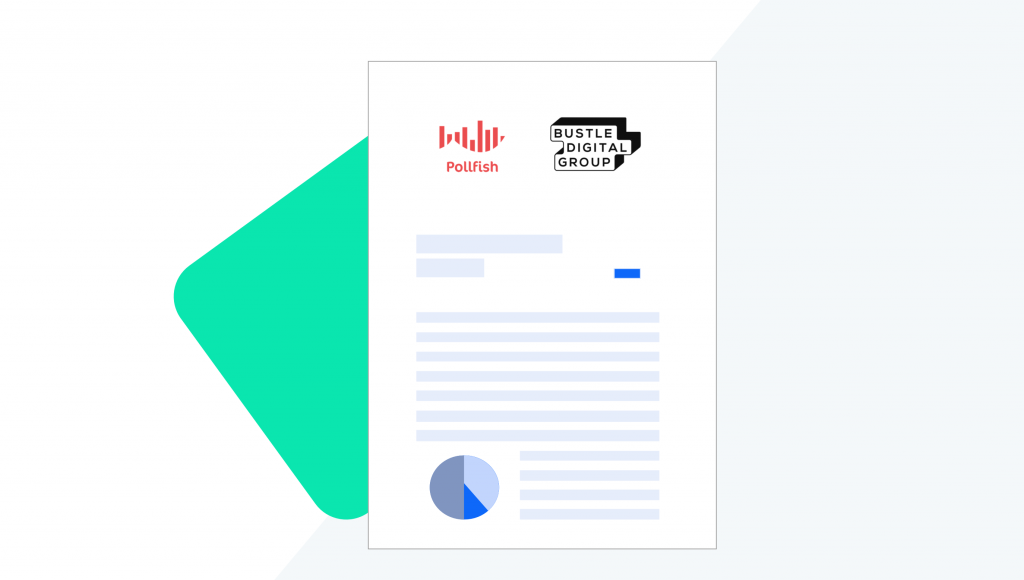
At its core, content creation is about using and designing the right content types and stories to connect a brand with its target audience. Storytelling, although always a part of human history, has evolved significantly due to technology, access, and channels by which we consume media today.
The Challenges in Modern Content Creation
With more ways to find and consume content than ever, along with professions such as content marketers, influencers, and podcasters dedicated to using content to build a deeper connection between consumers and brands, it can be difficult for brands to cut through the noise to reach their target audience.
Consumer behavior has also shifted from choosing products or services based solely on popularity. From where we eat to what we read, consumers use their wallets and social media platforms to express their beliefs and affiliations, meaning brands that want to stay relevant need to create content strategically.
Creating content that matters
Instead of pushing products or services, many brands have found that building authentic content is the best way to build trust with their target audience and differentiate themselves from competitors.
Examples include campaigns to align the brand with causes and movements that their target audience cares about, educational content to help them get the most from the product—even admitting their position in the market to present a transparent, trustworthy brand.
Building trust is even more essential for media companies who produce content for their readers to keep them informed and entertained. With so many sources for news and entertainment available to consumers, only companies that successfully connect with their audience in a meaningful way are able to maintain a competitive presence in the digital media landscape.
Content Strategy at Bustle Digital Group
Bustle Digital Group is a digital media company that has this approach figured out. The brands that make up Bustle Digital Group are all unique and unconventional, focusing on a distinct tone, interest, and following. Their approach to content creation is to develop content that focuses on the interests and behaviors of the niche audiences for each brand, rather than producing content for the masses.
They use research to dive deeper into understanding the target audience for each one to determine the type of content they should be producing, the stories they should be telling, and what their audience is looking for.
Content creation research
Bustle Digital Group has multiple ways of gathering data to be used for content creation. Their in-house insights team uses an internal panel of their readers to investigate what their most loyal readers are reacting to, what they care about, and for deeper, behavioral information that helps them determine storylines that resonate.
The insights team also conducts research using third-party tools, such as Pollfish, to help them uncover trends and reach new audiences who may or may not be current readers of their content.
Using a mix of methods to research themes, trends, and ideas leads to a complete picture of Bustle’s target audience that they can create impactful content for.
How Pollfish powers Bustle’s content creation
BDG uses Pollfish to gather data that can’t be obtained from their readers, which can include discovering new topics they want to cover or building out editorial pieces that they already know they plan to create.
Credible reporting
The insights team uses Pollfish to dive deeper into specific topics that their journalists want to report on, such as learning more about how mothers were impacted by the Coronavirus in a long-form piece for Romper, one of Bustle Digital Group’s brands.
Romper’s authors already knew that their readers would be interested in learning how mothers like themselves were being impacted by the coronavirus. To build the article’s credibility and impact, they chose to use Pollfish to survey 2,000 mothers across the United States to learn more about the topic.
Using Pollfish’s targeting capabilities, massive audience reach, and variety of question types, the insights team was able to effectively reach a representative sample of mothers and learn new information about a developing crisis, resulting in detailed data that authors used to create 7 infographics throughout the piece.
 New trends and topics
New trends and topics
Insights gathered from Pollfish surveys have also revealed new topics that journalists can cover. The Bustle Digital Group brand aims to develop content for progress and change, and being able to share the stories of underrepresented audiences is a part of that process.
When the insights team at Bustle Digital Group conducted a 2,000 person survey to learn more about niche audiences being affected by the COVID-19 pandemic, they uncovered unexpected trends that led to pieces that they otherwise may not have written.
One example was discovering that people believed that there was a social responsibility to support the greater good, yet not all groups have access to amenities that would make this possible, such as indigenous people living on reservations struggling with access to clean water during the pandemic. This sparked an insightful piece that shed light on an audience often neglected by other media outlets.
Content types to focus on
Although the Bustle team often already knows which types of content they want to produce, they also use Pollfish to validate that they are on the right track or define what is needed when they aren’t sure.
During COVID-19, Bustle Digital Group wasn’t sure whether their readers would want fun, distracting content pieces or more in-depth reporting on the pandemic. By asking questions about their readers’ mental health and what they might desire to help them during this time, Bustle was able to develop the right balance of informative and entertaining content during the global pandemic.
Content creators across all industries and experience levels can benefit from research being a part of their content creation process. Using Pollfish, Bustle Digital Group was able to get the insights they needed to make a difference and stay on brand rapidly and cost-effectively, even during a difficult time.
To use insights in your own creation process, create a free account with Pollfish and start building your own survey to learn what matters most to your target audience.
How Bustle reached niche survey audiences with Pollfish
How Bustle reached niche survey audiences with Pollfish
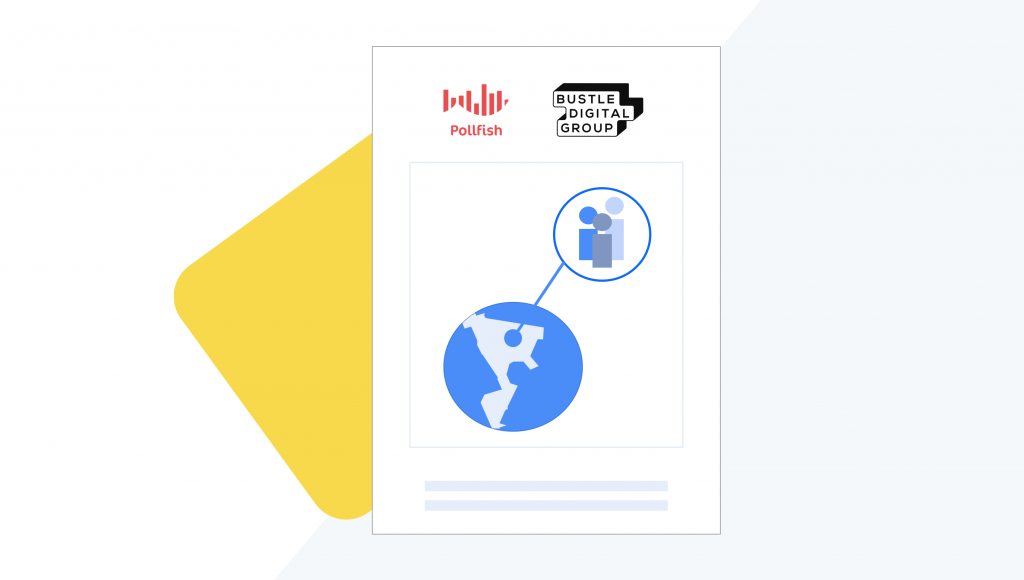
Reaching niche audiences is a tough challenge for any brand. And it has become more important than ever.
Reaching the right audience
Today’s consumer expects personalization and is seeking products, services, media, and more that fit their interests. With search engines and social media platforms that deliver more precisely every day, brands who know their niche audiences will have a distinct advantage over those who don’t.
Unfortunately, reaching these audiences is no easy task. For one thing, traditional methods of collecting opinions may not work as well for smaller or harder-to-find demographics. Survey panels are limited, homogeneous, and demographically inconsistent, especially on larger, more comprehensive surveys.
Technology presents new challenges. When trying to reach people who are savvier when it comes to technology, there are new considerations that a researcher must account for, especially when trying to reach younger “digital native” respondents.
From respondent experience to methodology to the types of questions you write, researchers must, to a certain extent, earn participation by building surveys that suit their niche audiences.
For a media company like Bustle Digital Group--which owns eight publications, all targeting niche audiences and all working to establish their brand voice and vision--the challenge is even tougher. Every brand decision they make as a parent company needs to consider the interests of all publications below, and vice versa.
This is the story of how Bustle used Pollfish to meet this challenge for its editorial staff, clients, and advertisers, all under the stress of a global pandemic.
Bustle’s Target Audience
With local news stations and newspapers across the country falling out of favor with consumers over the last 10 years, the brands that have survived have discovered new ways to deliver content and target it to their most valuable consumers.
Surveys have repeatedly shown that these preferences are changing fastest among women, especially women 18-24, or Gen Z.
Young people between 18-24 prefer to get their news from social media and receive it in more audio/visual forms like video, maps, interactive infographics, and podcasts.
These new forms of news delivery are especially popular among women, who today prefer to get their news through either word of mouth or social media.
These insights have driven the success of Bustle Digital Group since its founding in 2013. With 8 publications, all targeting niche audiences of Millennials, GenZ, and Women, BDG has set itself apart by using research to discover the wants and needs of its audiences and deliver traffic and insights to clients and advertisers.
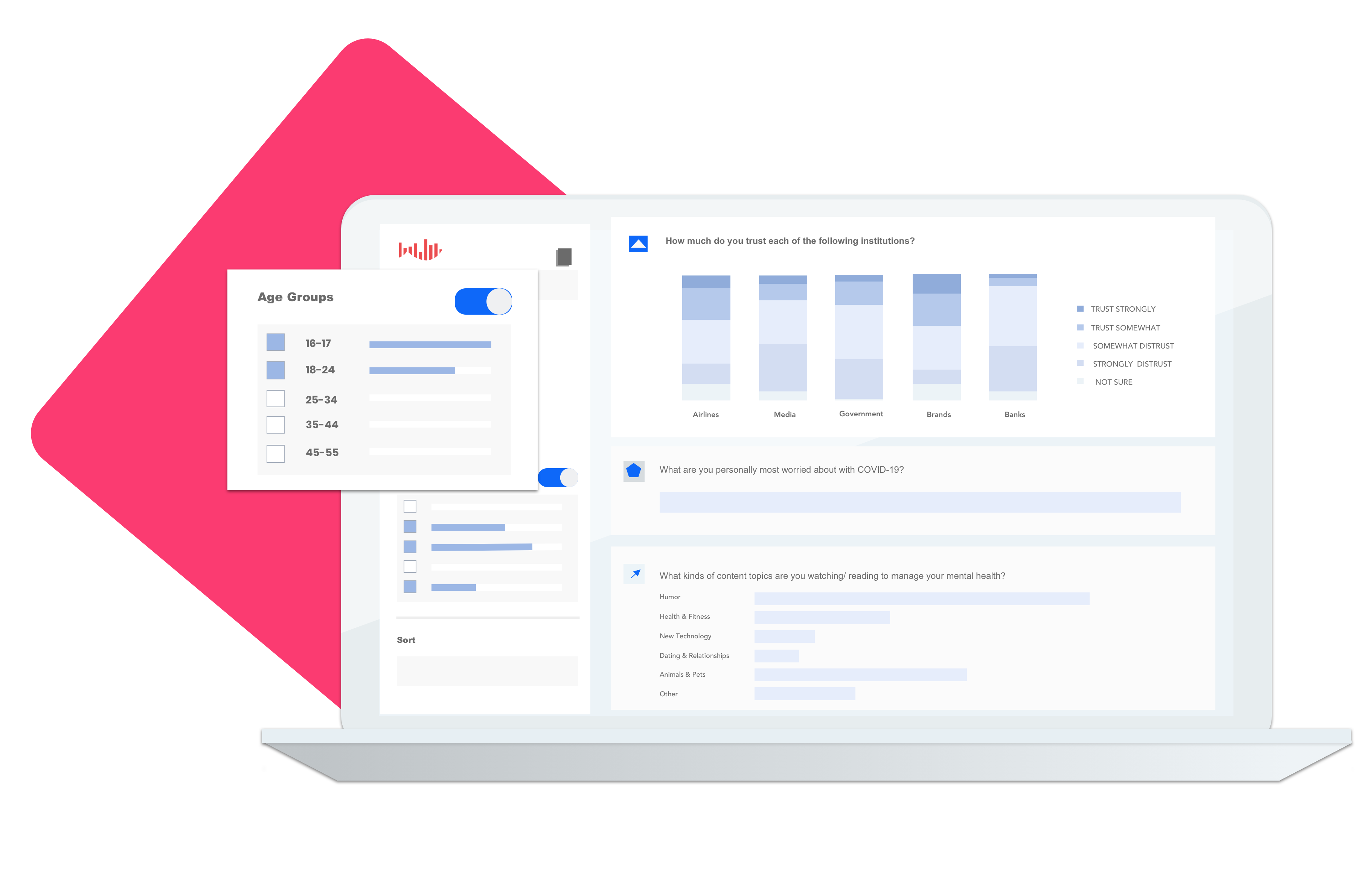
How Pollfish Helped
When COVID-19 hit earlier this year, BDG leaders were faced with a unique challenge--finding out what their diverse, underserved audience would want to read during a pandemic. What would their role be?
Bustle had some unique challenges. For a start, they needed to work quickly. With COVID-19 news breaking every day and 8 publications in need of editorial direction, they needed to reach their varied target audiences quickly.
Mobile surveys
For traditional survey platforms and panels, that could be a problem. Gen Z is a notoriously difficult group to survey. Gen Z typically doesn’t join panels proactively. Traditional methods of gathering respondents--email, social media, digital ads--get very low participation rates from digital natives, who have been advertised to in this way their entire lives.
Pollfish reaches respondents inside mobile apps, allowing more access to more people, including digital natives and people who would otherwise be too busy to complete a survey. By taking advantage of Pollfish’s ability to provide the convenience of completing surveys on devices, Bustle can reach a larger and more diverse audience.
Younger Audiences
When trying to reach younger members of Gen Z, most panels don’t enlist consumers under 18 years of age. But because Pollfish provides surveys to users inside mobile apps, we can collect responses from real consumers in real-time, as young as 16 years of age, and remain compliant with all global privacy laws.
And because Pollfish can deliver surveys to anyone who has downloaded an app within the Pollfish App Network, Bustle was able to choose from a network of over 700 million respondents worldwide, targeting down to the zip code, custom age ranges, and detailed demographics.

How Bustle Used Their Data
Using advanced targeting from Pollfish, Bustle could slice the data to build samples similar to the readership of each of their publications.
In March, Bustle created a survey of 2000 respondents. They targeted age groups between 16 and 44, with a nearly even split between males and females. Their goal was to better understand how millennials and Gen Z were feeling about the COVID-19 crisis. Bustle’s Associate Director of Research and Insights Dani Thibodeau had this to say:
“Whenever we create surveys, our first question is: what are we trying to learn? In that question, there’s usually a demographic included (i.e. how are Gen Z’s and millennials handling the pandemic differently?). That then informs how we are segmenting the survey and setting quotas so we can paint the most accurate picture in answering the question we’ve posed as our research objective.”
Bustle appreciated the ability to reach real consumers in real-time. They could then use this data to inform content decisions and deliver branded insights to clients and advertisers.
“Being able to reach real people about real issues just feels like a more accurate depiction of who our audience actually is,” Dani said.
For their study with the Clinton Foundation, Bustle took this niche segmentation even further. They were able to segment out essential workers, stay-at-home moms, moms newly working from home due to COVID, and moms who have recently been laid off due to COVID.
This detailed segmentation yielded some exciting results.
“An insight we found interesting was that overall, participants said there was not more tension with their partner during this difficult time,” Dani told us. “In fact, essential workers mentioned a more equal distribution of work in the household. We also discovered that working moms were spending several hours daily on planning educational activities for their children -- on top of the work they were doing for their jobs.”
Reassuring Clients & Advertisers
When the COVID-19 crisis began, clients and advertisers were understandably concerned. How would they be able to meet the needs of their customers and avoid tone-deaf messaging and initiatives?
Many of these brands turn to Bustle to reach Millennial and Gen Z audiences. Dani told us how Bustle delivered helpful insights.
“Brands and advertisers look to us as experts in the millennial and Gen Z landscape. By doing custom research we can share what’s on the minds of these sought-after audiences -- what they want from brands, what’s most important to them, what kinds of actions/messaging resonate best with them.”
This research delivered insights that helped brands excite and engage their customers while being sensitive to feelings around this public health crisis.
“We noticed early on that brand actions speak louder than words. As many brands changed messaging to “we’re all in this together”, Gen Z didn’t want to hear it unless there was a plan of action behind the messaging, like donating to causes, setting up relief funds for impacted communities, and using their resources to manufacture PPE and other necessary supplies.”
How Bustle Digital Group gained rapid audience insights during a crisis using Pollfish
How Bustle Digital Group gained rapid audience insights during a crisis using Pollfish
When a crisis hits, brand leaders must make hard choices.
How will their brand positioning, value proposition, feature set, and content evolve to meet the expectations, fears, and aspirations of a population gripped by doubt and uncertainty?
Leaders must make decisions quickly to both show leadership and keep progress moving forward at a critical time. But because jobs, revenue, and brand perception may be on the line, no leader takes these decisions lightly.
Now, imagine you have to meet this challenge for multiple content brands, across multiple platforms, reaching multiple audiences in multiple countries. And you need a decision right away.
That was the conundrum facing one of today’s leading global media companies, Bustle Digital Group. With a portfolio of distinct digital and experiential brands–Bustle, Mic, Elite Daily, Nylon, The Zoe Report, Input, and Inverse–BDG had to decide quickly how to respond to the COVID-19 pandemic, both as a parent company and as individual brands with individual audiences, voices, and topic areas.
Contents

The Challenge

The Challenge

When the COVID-19 crisis struck, businesses everywhere needed to understand what the impact would be on their offerings so they could make important decisions for managing the changing landscape. As a news source, Bustle Digital Group knew they wanted to shed light on the COVID-19 pandemic to their readers across their portfolio of sites. However, they were unsure how the crisis had affected their target audience and what impact that might have on their content consumption behavior or preferences for types of content consumed.
Bustle Digital Group also needed to consider its brand in the equation. As an unconventional media company, BDG knew that they didn’t want to offer the same hype and hysteria that other outlets were reporting on. Instead, they wanted to find ways to contribute positive, helpful content and provide support to their readers through the crisis one-day-at-a-time.
With information about COVID-19 updating constantly, BDG needed to gather data about the pandemic and its impact on the underrepresented groups that make up their brand audience. In order to produce timely and relevant pieces that cut through the noise and supported their readers in a time of need, they needed to gather insights instantly from hard-to-reach audiences across the US.
Bustle Digital Group also needed to consider its brand in the equation. As an unconventional media company, BDG knew that they didn’t want to offer the same hype and hysteria that other outlets were reporting on. Instead, they wanted to identify ways to contribute positive, helpful content and provide support to their readers through the crisis one-day-at-a-time.
With information about COVID-19 being updated constantly, BDG needed to gather data about the pandemic and its impact on the underrepresented groups that make up their brand audience. In order to produce timely and relevant pieces that cut through the noise and supported their readers in a time of need, they needed to gather insights almost instantly from hard-to-reach audiences across the US.

The Decision

The Decision

Before creating content that was a fit for BDG brands, the insights team needed to connect with their target audience to understand what type of content they were consuming, what they wanted and needed during the crisis, and whether their behaviors and attitudes had changed because of COVID-19.
This meant connecting with a diverse, representative audience to reach the people the mainstream media wasn’t covering and learning what matters most to them.
 “Being able to reach real people about real issues just feels like a more accurate depiction of who our audience actually is. Getting results fast from the right people has been a game changer. The project would not have been possible without Pollfish.” — Dani Thibodeau, Associate Director, Research and Insights, Bustle Digital Group
“Being able to reach real people about real issues just feels like a more accurate depiction of who our audience actually is. Getting results fast from the right people has been a game changer. The project would not have been possible without Pollfish.” — Dani Thibodeau, Associate Director, Research and Insights, Bustle Digital Group
BDG partnered with Pollfish— an in-house market research platform— to rapidly collect data that would bring the right balance of information (and distraction) to their readers during COVID-19.
By offering a single platform that includes audience selection and distribution, questionnaire building and an analytics dashboard, Pollfish offers a complete consumer survey creation experience that is easy for in-house teams to use quickly and efficiently.

The Solution

The Solution

BDG’s insights team got to work. Because their target audience can be hard to reach and needs to reflect the readership of 8 media publications, they needed a network of Pollfish’s size, scale, and distribution to ensure that they would obtain a representative audience sample.
Using Pollfish’s targeting capabilities to access an audience of over 750M consumers, BDG’s insights team was able to easily set quotas and select demographic information to define younger audiences, multiple ethnic groups, and a diverse range of socio-economic statuses across the United States.




BDG created and launched a survey to 2,000 respondents across every age group, race, and gender to learn more about how COVID-19 was affecting different groups of people throughout the US.
Within 3 days, they had their answers.
Using Pollfish, the insights team at Bustle Digital Group was able to gain data on the attitudes and behaviors of their primary audience demographic, as well as uncover unexpected findings and fears regarding COVID-19 that the editorial teams were able to use to create the right stories and content types for BDG’s readers.

The Results

The Results

Bustle Digital Group got the information they needed to make important decisions during COVID-19 instantly. The insights team used their findings to inform internal conversations across multiple departments and executives on where their readership was during the pandemic. They were able to generate reports for their advertising partners, offering data-backed updates that showed where the market was going and built confidence for these partnerships that Bustle Digital Group understood their audience.
By offering robust data from their target audience using Pollfish, the insights team at Bustle Digital Group was able to fuel 5 thought leadership projects for the BDG sales organization to share across channels and reassure their advertising sponsors that they were still connecting effectively with the audiences they intended to reach, as well as assisting Bustle’s business development team with data that could help them pitch new partners successfully.
With one Pollfish survey, the insights team gathered data to develop compelling, interesting content for readers across the Bustle Digital Group family of brands. They were able to create 3 editorial pieces for Mic and Bustle publications, garnering thousands of views of their original content.
Additional COVID-19 studies were completed with equal success, including another 2,000-person survey in collaboration with the Clinton Foundation that shed light on the plight of mothers in the pandemic. Romper, one of BDG’s brands that focuses on new mothers, was able to get results from a representative sample of their target audience in 4 days to quickly curate 7 different infographics and a long-form article, exposing the shift and impact the virus has had on mothers, families, and the expectations of different household roles. Authors at Romper were able to tell a complete story to their readers that although they are quarantined, they are not alone.
By offering robust data from their target audience using Pollfish, the insights team at Bustle Digital Group was able to fuel 5 thought leadership projects for the BDG sales organization to share across channels and reassure their advertising sponsors that they were still connecting effectively with the audiences they intended to reach, as well as assisting Bustle’s business development team with data that could help them pitch new partners successfully.
With one Pollfish survey, the insights team gathered data to develop compelling, interesting content for readers across the Bustle Digital Group family of brands. They were able to create 3 editorial pieces for Mic and Bustle publications, garnering thousands of views of their original content.
Additional COVID-19 studies were completed with equal success, including another 2,000-person survey in collaboration with the Clinton Foundation that shed light on the plight of mothers in the pandemic. Romper, one of BDG’s brands that focuses on new mothers, was able to get results from a representative sample of their target audience in 4 days to quickly curate content that let these women know that although they are quarantined, they are not alone.




 New trends and topics
New trends and topics







